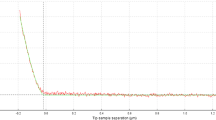Abstract
These experiments were done to optimize the surface properties of polylactide film designed for human keratinocyte cultivation. The film was covered with type 1 collagen to increase its hydrophilic properties. The method of protein application determines the consistency the matrix coating and the formation of different collagen structures on the film. Substrates modified by collagen affect the growth of cultured keratinocytes. Our data on keratinocyte spreading, morphology and cytoskeleton organization demonstrate that the best form of collagen to use to cover the polymeric surface is the fibrillar isoform.
Similar content being viewed by others
References
Sved, Yu.A., Kukhareva, L.V., Zorin, I.M., et al., Biodegradable polymer surface for cultured human skin fibroblasts, Tsitologia, 2006, vol. 48, no. 2, pp. 161–168.
Boyce, S.T. and Warden G.D., Principles and practices for treatment of cutaneous wounds with cultured skin substitutes, Am. J. Surgery, 2002, vol. 183, pp. 445–456.
Brekke, J.H., Architectural principles applied to three-dimensional therapeutic implants composed of bioresorbable polymers, in Encyclopedic handbook of biomaterials and bioengineering, Part A, Materials (Marcel Dekker Inc, New York, 1995), vol. 1, pp. 689–731.
Chandrakasan, G., Torchia, D.A., and Piez, K.A., Preparation of intact monomeric collagen from rat tail tendon and skin and the structure of the nonhelical ends in solution, J. Biol. Chem., 1967, vol. 251, pp. 6062–6067.
Dai, N.-T., Williamson, M.R., Khammo, N., et al., Composite cell support membranes based on collagen and polycaprolactone for tissue engineering of skin, Biomaterials, 2004, vol. 25, no. 18, pp. 4263–4271.
Dawson, R.A., Goberdhan, N.J., Freedlander, E., and MacNeil, S., Influence of extracellular matrix proteins on human keratinocyte attachment, proliferation and transfer to a dermal wound model, Burns. 1996, vol. 22, no. 2, pp. 93–100.
Djabourov, M., Lechaire, J.-P., and Gaill, F., Structure and Rheology of gelatin and collagen gels, 1993, Bioreology, vol. 30, pp. 191–205.
Garric, X., Moles, J.-P., Garreau, H., et al., Human skin cell cultures onto PLA50 (PDLLA) bioresorbable polymers, in Influence of chemical and morphological surface modifications (Wiley Periodicals, Inc, 2004, November, pp. 180–189).
Jensen, P. and Bolund, L., Low Ca2+ stripping of differentiating cell layers in human epidermal cultures: an in vitro model of epidermal regeneration, Exp. Cell Res, 1988, vol. 175, pp. 63–73.
Kim, B.-S. and Mooney, D.J., Development of biocompartible synthetic extracellular matrices for tissue engineering, Tibtech May, 1998, vol. 16, pp. 224–230.
Kitajima, Y., Protein metabolism during the stratum corneum formation: molecular aspects of keratinization, cell adhesions and cytoskeletons, Skin: Interface of a living System, 1998.
Langer, R. and Vacanti, J.P., Tissue engineering, Science, 1993, vol. 260, pp. 920–926.
Mercier, I., Lechaire, J.-P., Desmouulier, A., et al., Interactions of Human Skin Fibroblasts with monomeric or Fibrillar Collagens induce Different Organization of the Cytoskeleton, Exp. Cell Res., 1996, vol. 225, pp. 245–256.
Nishiyama, T., Tsunenaga, M., Akutsu, N., et al., Role of dermal-epidermal communication on regulation of skin structure and function Skin: Interface of a Living System, 1998.
Rheinwald, J.G., Serial cultivation of normal epidermal keratinocytes, Meth. Cell Biol. 1980, vol. 21A, pp. 229–254.
Ruszczak, Z.B., Modern aspects of wound healing: an update, Dermatol. Surg., 2000, vol. 26, pp. 219–229.
Sato, K., Hattori, S., Irie, S., and Kawashima, S., Spike formation by fibroblasts adhering to fibrillar collagen I gel, 2003, Cell Str. Func, vol. 28, pp. 229–241.
Strom, S. C. and Michalopoulos G., Collagen as a substrate for cell growth and differentiation, Meth. Enthymol. 1982, vol. 82, pp. 544–555.
Tjia, J.S., Aneskievich, B.J., and Moghe, P.V., Substrate-adsorbed collagen and cell secreted fibronectin concertedly induce cell migration on poly (lactide-glycolide) substrates. Biomaterials, 1999, vol. 20, nos. 23–24, pp. 23–2233.
Author information
Authors and Affiliations
Additional information
Original Russian Text © Yu.A. Shved, L.B. Kukhareva, I.M. Zorin, M.I. Blinova, A.Yu. Bilibin, G.P. Pinaev, 2007, published in Tsitologiya, Vol. 49, No. 1, 2007, pp. 32–39.
Rights and permissions
About this article
Cite this article
Shved, Y.A., Kukhareva, L.B., Zorin, I.M. et al. Interaction of cultured skin cells with the polylactide matrix coved with different collagen structural isoforms. Cell Tiss. Biol. 1, 89–95 (2007). https://doi.org/10.1134/S1990519X07010117
Received:
Issue Date:
DOI: https://doi.org/10.1134/S1990519X07010117




